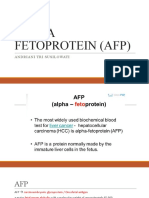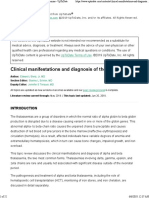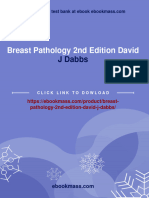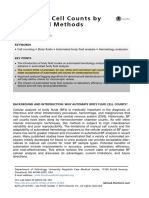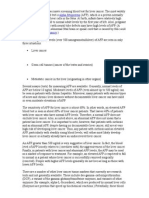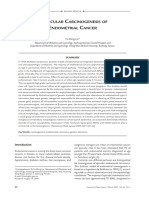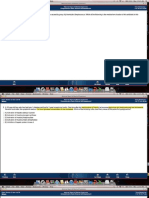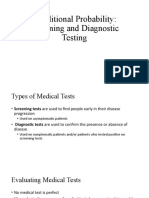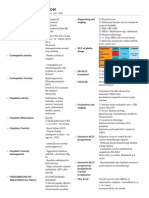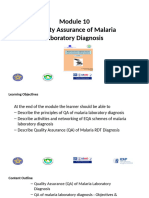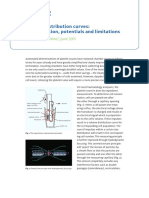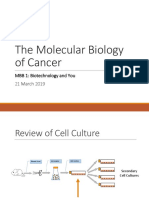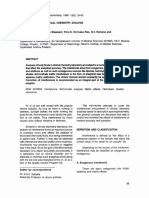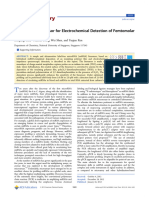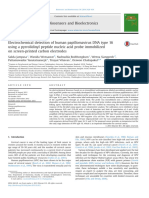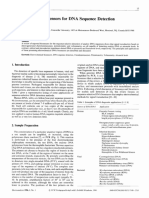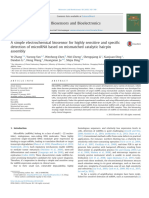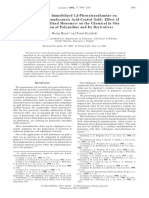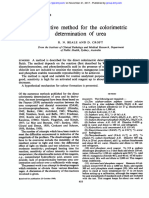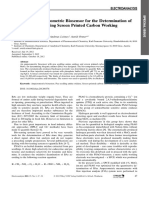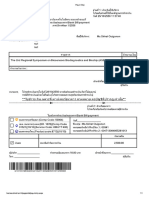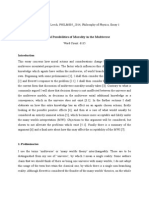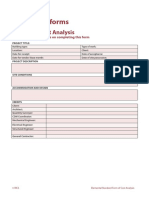"OMIC" Tumor Markers For Breast Cancer: A Review
"OMIC" Tumor Markers For Breast Cancer: A Review
Uploaded by
wardaninurindahCopyright:
Available Formats
"OMIC" Tumor Markers For Breast Cancer: A Review
"OMIC" Tumor Markers For Breast Cancer: A Review
Uploaded by
wardaninurindahOriginal Title
Copyright
Available Formats
Share this document
Did you find this document useful?
Is this content inappropriate?
Copyright:
Available Formats
"OMIC" Tumor Markers For Breast Cancer: A Review
"OMIC" Tumor Markers For Breast Cancer: A Review
Uploaded by
wardaninurindahCopyright:
Available Formats
Open Access
Review Article
“OMIC” tumor markers for
breast cancer: A review
Naila Irum Hadi1, Qamar Jamal2
ABSTRACT
Breast cancer is a global health issue, and as the tumor burden increases, we need to come up with newer,
better technologies which are convenient, cheap, rapid, sensitive with a high specificity. Technological
advancements in the field of cancer biomarker has led to the development of techniques such as mass
spectrometric analysis and microarray analysis in which genes, proteins and hundreds and thousands
of metabolites can be identified with the emergence of genomics, proteomics and metabolomics. This
research is focused on finding biomarkers for diagnosis, prognosis, staging, treatment response and targets
for chemotherapy, generating a panel of markers which provide better clinical information compared
to a single marker in the panel. This review briefly summarizes application of genomics and proteomics
followed by key concepts and applications of metabolomics in breast cancer, with the conclusion that an
integration of the three “OMIC” technologies may hold the key to future biomarker discovery.
Sources of Data/Study Selection: The information for this review was collected by searching the Google
Scholar and PubMed database for English articles published in the period from 2002 to 2015. The search terms
included “biomarkers in breast cancer” along with the following search terms: “genomics”, “proteomics”,
“metabolomics”, “breast cancer”, “mass spectrometry”, “molecular markers” and “cancer biomarker”.
We have endeavored to quote only the primary sources. Titles and abstracts of retrieved studies were
assessed first followed by selection and retrieval of selected full text articles.
KEY WORDS: Biomarker, Breast cancer, Genomics, Proteomics, Metabolomics.
Abbreviations:
ASCO – American Society of Clinical Oncology, ER – estrogen receptor, PgR – progesterone receptor, HER2 – human
epidermal growth factor receptor 2,CA – cancer antigen, TAILORx – Trial Assigning Individualized Options for
Treatment (Rx), MINDACT – Microarray InNode Negative Disease may Avoid ChemoTherapy using Mammaprint®, FDA
– Federal Drug Authority, GC-TOF-MS – time of flight, LC/ESI-MS – electrospray ionization, PCho – phosphocholine,
GPCho – glycerophosphocholine, Cdx-2 – caudal type homebox 2, KiSS1 – Kisspeptin 1, KAL1 – Kallman syndrome 1
sequence, NIST – National Institute of Standards and Technology, HMDB – Human metabolome database.
doi: http://dx.doi.org/10.12669/pjms.315.7627
How to cite this:
Hadi NI, Jamal Q. “OMIC” tumor markers for breast cancer: A review. Pak J Med Sci 2015;31(5):1256-1262.
doi: http://dx.doi.org/10.12669/pjms.315.7627
This is an Open Access article distributed under the terms of the Creative Commons Attribution License (http://creativecommons.org/licenses/by/3.0),
which permits unrestricted use, distribution, and reproduction in any medium, provided the original work is properly cited.
1. Dr. Naila Irum Hadi, MBBS, MPhil, PhD fellow.
Professor of Pathology,
INTRODUCTION
2. Dr. Qamar Jamal, MBBS, MPhil, PhD.
Professor of Pathology, Breast cancer (BC) is a major health issue in
1, 2: Ziauddin University, Karachi, Pakistan. women Worldwide as well as in Pakistan. Howev-
Correspondence: er marked geographic variation has been noted in
Dr. Naila Irum Hadi, MBBS, MPhil, PhD fellow. the incidence, natural course of the disease as well
Pathology Department, Ziauddin University, as survival statistics. This is reflected in the com-
4/B, Shahrah-e-Ghalib, Block-6, Clifton,
Karachi-75600, Pakistan.
parison between age standardized rates (ASR) and
E-mail: nailahadi@yahoo.com survival rates (SR) of North American women with
* Received for Publication: March 5, 2015
that of Pakistani women i.e. ASR of 99.4 per 100,000
* Revision Received: July 16, 2015
and SR of 80%1 for the former with ASR of 69.1 per
* Revision Accepted: July 25, 2015 100,0002 and SR of less than 40% for the latter.1 The
1256 Pak J Med Sci 2015 Vol. 31 No. 5 www.pjms.com.pk
OMIC tumor markers for breast cancer
gravity of the situation further increases when it is study for prediction of breast cancer relapse)9 and
noted that BC in Pakistan affects younger women OncotypeDx (Genome Health, Redwood city,
with an advanced stage at the time of presentation.3 CA, USA) (a 21 gene expression profile by RT-
This puts an enormous burden on the resources PCR).10 These have been approved by FDA and
of a poor country like Pakistan. Mammography are commercially available since 2007 and 2004
for screening, histopathology and blood tests for respectively. Their value in assessing individualized
diagnosis, prognosis and treatment are considered options for treatment in selection of an effective
gold standards for breast cancer.4 According to and appropriate chemotherapeutic agent for breast
2007 recommendations of ASCO for tumor markers cancer patients is being explored in ongoing clinical
ER, PgR and HER2 expression in primary invasive trials: TAILORx11 and MINDACT,12 but their routine
breast cancer should be evaluated for diagnosis clinical use is not yet recommended.13
or recurrence especially as a guide for therapy, Recently researchers are interested in finding out
while increasing levels of CA 27.29 or CA 15-3 may whether other ‘omic’ technologies can also add to
indicate treatment failure.5 This however cannot be the information provided by genomics.14 Elevated
applied to all breast tumors leaving a wide gap in levels of protein in biological fluid in cancer can be
our understanding of this heterogeneous tumor. due to atypical secretion, shedding of membrane-
Hence development of new methods for exploring associated proteins, change in cancer cells polarity,
the molecular pathogenesis of this disease becomes increased expression of proteases15 and single
imperative. Detection of malignancy by a sample nucleotide polymorphism (SNP) of signal peptide,16
blood test for identification of tumor markers etc. HER2 is a cancer biomarker, and classic example
has been explored thoroughly in medical field. of a membrane bound tyrosine kinase, that is shed
These biomarkers are released by the tumor itself into fluids. HER2 protein has an extracellular
or by other tissues as a reaction to the tumor or domain (ECD), a transmembrane domain and a
inflammation occurring in response to tumor. cytoplasmic domain. The ECD of HER2 is cleaved
An ideal tumor marker is easily measured, reliable, by a protease from the receptor protein and can be
and cheap, with a high sensitivity and specificity. detected as a biomarker in serum. Over expression
It should help not only in screening early cancer of HER2 seen in some cases of breast cancer is an
but also recurrence, vary with different stages of indicator of poor prognosis for these patients.5
disease and has prognostic and predictive value.6 Since 2000, HER2 test has been approved by FDA
This review briefly covers the concepts of and is used in the management and follow-up of
genomics and proteomics, followed by an in-depth patients with metastatic breast cancer.
analysis of the evolving field of metabolomics for mRNA transcript does not reflect the function
biomarker discovery in breast cancer. of proteins, hence different proteomic strategies in
1. “Omics” in Breast Cancer: biomarker discovery have emerged as proteins in
In the quest for identification of a suitable biomarker complex mixtures require systemic characterization
for breast cancer, novel and high-yield technologies by mass spectrometry (MS). Limitation of MS
like genomics, proteomics, and metabolomics have for proteomic approaches include improper
received a lot of attention in recent times, prompt- sample collection and storage, inability to
ing the researchers to name this as the era of “Breast identify established serological biomarkers, bias
cancer – OMICS”.7 Studies have shown that malig- in identification of high-abundance molecules
nant transformation of normal breast tissue and within the serum, conflict in reporting of ms peaks
evolution of metastatic clone involves altered gene reported by different research laboratories17,18 and
expression (altered transcription) or altered protein possible artifacts in bioinformatics.19 Hence serum
expression (altered translation).8 This has led to the proteomic analysis and profiling is not currently
development of promising technologies of genom- recommended for clinical use by experts.13
ics, proteomics (respectively) and metabolomics. Enzymes are proteins, and there should be good
Gene expression profiles of certain predictive quantitative relationship between mRNA concen-
and prognostic markers of breast cancer have tration and enzyme function. But on the contrary,
been developed and are available commercially metabolites which are downstream are better indi-
such as molecular technologies for improvement cators of enzyme activity,20 and are more sensitive
in breast cancer diagnosis and treatment with monitors of a change in biological system, repre-
the development of MammaPrint (Agendia, sented by the genome (‘genomics’), transcriptome
Amsterdam, The Netherlands) (a 70 gene microarray (‘transcriptomics’), proteome (‘proteomics’) and
Pak J Med Sci 2015 Vol. 31 No. 5 www.pjms.com.pk 1257
Naila Irum Hadi et al.
metabolome (‘metabolomics’). At the end of the coupled with gas chromatography (GC-MS) (iden-
spectrum, metabolome represents the phenotypic tification of approximately 1000 metabolites), with
changes and even slight alterations in metabolites liquid chromatography (LC-MS) (identification of
can be detected.21 Hence cancer researchers have re- hundreds of metabolites) or capillary electrophore-
newed interest in the field of metabolomics for the sis (CE-MS).NMR MS identifies a variable number
discovery of specific biomarkers for use as diagnos- of metabolites depending on the nature of samples
tic or prognostic markers.21 i.e. 20 – 40 metabolites in tissue samples and 100
2. Metabolomics: – 200 in urine samples.20,25 GC-MS and LC-MS are
Warburg effect (put forward by Otto Warburg commonly used techniques for cancer samples.21
in 1924)is characterized by an increase in glucose Benefits of NMR include high reproducibil-
uptake by cancer cells converting it into lactate by ity, ability to quantify metabolites in complex mix-
glycolysis in spite of normal oxygen supply, hence tures and metabolite detection in vivo, as well as
also called ‘aerobic glycolysis’ or ‘aerobic fermenta- in biological fluids and tissues without any prior
tion’.22 Cancer cell is also shown to have an altered preparation of the sample. Its main disadvantage
protein metabolism and altered lipid metabolism.23 is its low sensitivity.27 An improvement of NMR
Hence cancer is regarded as a disease with gene spectroscopic procedure is a technique called high
mutation resulting in changes in gene expression to resolution magic angle spinning (HR-MAS) NMR
produce a metabolic phenotype with altered glyco- spectroscopy, which involves spinning of a biopsy
lytic, amino acid, nucleotide and glycerophospho- sample at an angle to the magnetic field, to improve
lipid / lipid metabolism. This results in a cancer cell the spectrum resolution.28 Its advantage include si-
phenotype resulting in cancer cell growth, differen- multaneous in situ assessment of both aqueous and
tiation and survival. lipid soluble metabolites.23 High resolution NMR
Metabolomics technology involves identifica- (HR-NMR) and HR-MAS MRS can be used on bio-
tion of hundreds to thousands of metabolites and fluids and tissues as they do not cause destruction
exploring multiple cellular pathways at the same of samples making it possible to carry out parallel
time. Presence of small molecules in the body flu- analysis.29
ids or tissues contribute to the construction of a Benefits of GC-MS include high sensitivity, quan-
unique ‘fingerprint’, distinguishing between dis- tification of metabolites and ability to identify more
ease and health implying that metabolomics can compounds in comparison to other MS techniques.
distinguish between cancer and normal tissues. So Its main limitation is complex and lengthy steps
metabolomics is emerging as a promising new ‘om- involved in sample preparation and interpretation
ics’ field7 a high throughput technology increasing- of its spectra. Benefits of LC-MS is its use for non-
ly being used for breast cancer research especially volatile compounds, quantification of wide range a
for screening, diagnosis, cancer typing, staging and of metabolites and its complementary nature to GC-
therapeutic intervention.21,24 Advantages of metabo- MS.21
lomics include being cost-effective, high through- CE-MS separates and identifies polar or ionic
put, and being automated with sample analysis compounds in complex mixtures, has high
taking 10 to 30 minutes per sample approximately.23 resolution with no complex and laborious sample
Two terms are frequently used in metabolomics; handling as for GC-MS, and has low sensitivity but
‘metabolic profiling’ and ‘metabolic fingerprint- high variability than that of LC-MS or GC-MS.21
ing’. Metabolic profiling refers to a measure of total 2.2 Diagnosis, Prognosis & Treatment of Breast
number of individual metabolites in a sample while Cancer:
metabolic fingerprinting means measuring a group Heterogeneity of breast cancer (BC) ranges from its
or class of metabolites or quantification of a limited morphology, to prognosis, to metastatic potential
number of metabolites to differentiate between dif- and to treatment response. Studies carried out for
ferent samples.25 In spite of recent advances in the understanding breast cancer pathogenesis are aimed
field of metabolomics its application has been lim- at identification of biomarkers and new targets for
ited by technical problems. effective cancer chemotherapy.30 A GC-TOF MS
2.1 Metabolomic Approaches: based metabolomics study in breast cancer detected
Most popular methods for metabolomics include 368 metabolites that differentiated between cancer
mass spectrometry (MS) and nuclear magnetic res- and normal tissues, a property that can be utilized
onance (NMR) spectroscopy,26 which are comple- for screening of breast cancer. The ratio of cytidine-5-
mentary to each other. Mass spectrometry can be monophosphate / pentadecanoic acid was the most
1258 Pak J Med Sci 2015 Vol. 31 No. 5 www.pjms.com.pk
OMIC tumor markers for breast cancer
Fig.1: Schematic representation of “-Omic” platforms in breast cancer biomarker discovery.
Pak J Med Sci 2015 Vol. 31 No. 5 www.pjms.com.pk 1259
Naila Irum Hadi et al.
specific and sensitive discriminator.31 In a research multivariate statistical methods to identify 11 me-
carried out to observe changes in lipid metabolism, tabolites which can predict recurrence with a sensi-
an important feature of cancer, increased levels of tivity of 86% and specificity of 84%. By combining
sn-glycerol-3 phosphate was detected by GC-MS, NMR and LC- MS, four metabolites namely threo-
and increased levels of phospholipids by LC-MS in nine, glutamine, isoleucine and linolenic acid were
breast cancer tissue.32 found to be predictors of response to neoadjuvant
Breast cancer prognosis can be predicted by ana- chemotherapy. Breast cancer patients were placed
lyzing the metabolic profile and comparing with into three groups, i.e. with no response, partial re-
survival rates. Giske degård et al.33 analyzed breast sponse, or complete response. Altered metabolic
cancer tissue by HR-MAS MRS and found high lev- profiles were seen for these four amino acid me-
els of glycine and lactate in a subgroup of ER posi- tabolites which distinguished between the different
tive breast cancer patients with lower survival rates groups.40
and hence poor prognosis. The other subgroup of ER Pharmacometabolomics, a promising and novel
positive patients had better prognosis while these field can predict response to chemotherapeutic
metabolic changes (elevated glycine and lactate) agents. In patients with metastatic breast can-
were not seen in ER negative patients. In another cer treated with paclitaxel and lapatinib, serum
study it was reported that ER positive Luminal type metabolic profile was analyzed before and during
A breast cancer has a variable response to hormone chemotherapy, and was found to have a positive
therapy, dividing this group into responders and correlation with patient survival and time to pro-
non-responders. Metabolomic analysis of luminal gression in HER2 positive patients. Metabolomics
type A identified three groups with the help of ‘a’ also helped in selecting the subset of HER2 positive
and ‘b’ glucose amino acids, myoinositol and lipid breast cancer patients with metastatic disease who
residues. Gene analysis of one of the group of lumi- were responsive to this combination therapy.41
nal A subtype showed its relationship to cell cycle “Omics” in Pakistan: Present and Future:
and DNA repair and most probably represented the Different types and sites of BRCA 1 and 2 gene mu-
non-responders to hormone therapy.34 tations, known risk factors for breast cancer, have
Increased levels of total choline (t-Cho) contain- been studied extensively in Pakistani women with
ing compounds have been detected in breast cancer BC (both sporadic as well as familial cases).42-44
cells forming a basis for many metabolomics analy- Breast cancer research in recent times is focusing
sis carried out in these patients.35-37 For example, in more on gene polymorphisms other than BRCA 1
a study carried out by Mimmi et al.(2011),36 breast and 2 as a possible explanation for racial differences
tissue biopsies from normal subjects, patients with in incidence, clinical presentations and prognosis
fibrocystic disease, benignlesions and breast cancer of breast cancer. Prevalence of TP53 mutations in
were analyzed by LC / ESI-MS for the presence of BRCA1 & 2 negative young Pakistani BC patients (≤
Cho, PCho and GPCho. Results showed raised lev- 30 years) was assessed, uncovering novel mutations
els of choline and its phosphorylated metabolites in which can account for a subset of cancers occurring
subjects with benign and malignant tumors only. in the younger age group.45An association between
Metastasis in breast cancer has also been detected vitamin D receptor Cdx-2 gene polymorphism and
with the help of a distinct metabolic profile in the risk of breast cancer in premenopausal women re-
serum or urine of these patients.35,38 Similarly serum vealed an increased risk of BC in young women
metabolic profile by NMR showed that metastatic with GG genotype,46 while another study reported a
breast cancer can be differentiated from early stage reduced expression of metastasis suppression genes
breast cancer with a prediction accuracy of 72%.35 (KiSS1 and KAL1) in Pakistani BC patients.47 Ab-
Jobard et al.39 carried out serum metabolomics by sence of FANCM c. 5101c >: T mutation in triple
HNMR to differentiate between localized early dis- negative and BRCA 1 & 2 negative patients48 and
ease (EBC) and metastatic breast cancer (MBC) with insignificant role of RAD51C, a gene responsible for
respect to diagnosis, prognosis and management of DNA repair and stability of genome, in BRCA 1 & 2
these patients. He constructed a model with 9 dif- negative BC patients49 have also been reported.
ferentiating metabolites which included histidine, Literature search regarding proteomics research
acetoacetate, pyruvate, glycerol, glycoprotein (N- in Pakistan yielded a single article reporting a dis-
acetyl), glutamate, mannose and phenylalanine. tinct proteomic profile distinguishing between
Asiago et al.38 studied recurrence of breast cancer breast cancer, benign breast lesions and healthy
by a combination of analytical (NMR, GC- MS) and controls, serving as diagnostic biomarkers. Sera of
1260 Pak J Med Sci 2015 Vol. 31 No. 5 www.pjms.com.pk
OMIC tumor markers for breast cancer
the three groups were analyzed by one-dimension- 10. Paik S, Shak S, Tang G, Kim C, Baker J, Cronin M, et al.
al SDS polyacrylamide gel electrophoresis (PAGE) A multigene assay to predict recurrence of tamoxifen-
treated, node-negative breast cancer. N Engl J Med.
and protein identified through LC/MS/MS.50 Simi- 2004;351:2817–2826.
larly in spite of global advances in field of biomark- 11. Coates AS, Colleoni M, Goldhrisch A. Is adjuvant
er discovery for BC by metabolomics, to the best chemotherapy useful for women with luminal A
of our knowledge no work has been carried out in breast cancer? JCO. 2012;30(12):1260-1263. doi:10.1200/
JCO.2011.37.7879
Pakistan. Currently we are working on BC metabo- 12. Cardoso F, Van’t Veer L, Rutgers E, Loi S, Mook S, Piccart-
lomics biomarker project, which is in final stage of Gebhart MJ. Clinical application of the 70 gene profile: The
completion, in collaboration with H.E.J. research MINDACT trial. JCO. 2008;26(5):729-735. doi: 10.1200/
institute of chemistry, Dr. Panjwani Center for Mo- JCO.2007.14.3222.
lecular Medicine and Drug Research (PCMD), Uni- 13. Sturgeon CM, Hoffman BR, Chan DW, Ch’ng SL,
Hammond E, Hayes DF, et al. National Academy of Clinical
versity of Karachi. Biochemistry Laboratory Medicine Practice Guidelines
for use of tumor markers in clinical practice: quality
CONCLUSION requirements. Clin Chem. 2008;54:1-27. doi: 10.1373/
clinchem.2007.094144.
High-throughput “omic” technologies, especially 14. Howell A. Can metabolomics in addition to genomics add
metabolomics is a promising evolving field for to prognostic and predictive information in breast cancer?
advancing our knowledge and understanding BMC Medicine. 2010;8:73. doi:10.1186/1741-7015-8-73
of breast cancer pathogenesis, identification of 15. Kulasingam V, Diamandis EP. Strategies for discovering
novel cancer biomarkers through utilization of emerging
diagnostic biomarkers, tumor typing and staging,
technologies. Nat Clin Pract Oncol. 2008;5:588-599.
and response to therapy. Extensive and widespread doi: 10.1038/ncponc1187
studies employing a large sample size are required 16. Jarjanazi H, Savas S, Pabalan N, Dennis JW, Ozcelik H.
for proper validation of these different biomarkers. Biological implications of SNPs in signal peptide domains
Clinical application of “omics” approach can of human proteins. Proteins. 2008;70(2):394–403.
17. Diamandis EP. Mass spectrometry as a diagnostic and a
further be improved by integration of genomics, cancer biomarker discovery tool. Molecular & Cellular
proteomics and metabolomics, thus exploring new Proteomics. 2004;3:367–378. doi: 10.1074/mcp.R400007-
frontiers in biomarker discovery for breast cancer. MCP200
18. Karsan A, Eigl BJ, Flibotte S, Gelmon K, Switzer P, Hassell P, et
REFERENCES al. Analytical and preanalytical biases in serum proteomic
pattern analysis for breast cancer diagnosis. Clin Chem.
1. Coleman MP, Quaresma F, Berrino J, Lutz JM, De Angelis 2005;51(8):1525–1528. doi: 10.1373/clinchem.2005.050708
R, Capocaccia R, et al. Cancer survival in five continents: 19. Baggerly KA, Morris JS, Edmonson SR, Coombes ER. Signal
a worldwide population based study (CONCORD). in noise: evaluating reported reproducibility of serum
Lancet Oncol. 2008;9(8):730-756. doi: 10.1016/S1470- proteomic tests for ovarian cancer. J Natl Cancer Inst.
2045(08)70179-7. 2005;97(4):307–309. doi: 10.1093/jnci/dji008
2. Bhurgri Y, Bhurgri A, Nishter S, Ahmed A, Usman
20. Spartlin JL, Serkova NJ, Eckhardt SG. Clinical applications
A, Pervez S, et al. Pakistan - country profile of cancer
of metabolomics in oncology: a review. Clin Cancer Res.
and cancer control 1995-2004. J Pak Med Assoc.
2009;15(2):431-440. doi: 10.1158/1078-0432.CCR-08-1059.
2006;56(3):124-130.
21. Armitage EG andBarbas C. Metabolomics in cancer
3. Khokher S, Mahmood S, Khan SA. Response to neoadjuvant
biomarker discovery: Current trends and future
chemotherapy in patients withadvanced breast cancer:
perspectives. J Pharmaceutical Biomedical Analysis.
A local hospital experience. Asian Pac J Cancer Prev.
2014;87:1-11. doi: 10.1016/j.jpba.2013.08.041
2010;11(2):303-308.
22. Stricker TP, Kumar V. Growth promoting metabolic
4. Shi L.Racial differences in breast cancer patterns. Science.
2010;329(5987):32. doi: 10.1126/science.329.5987.32-a alterations: The Warburg Effect. In Neoplasia (Chapter
5. Harris L, Fritsche H, Mennel R, Norton L, Ravdin P, Taube 7). Robbins and Cotran pathologic basis of disease.
S, et al. American Society of Clinical Oncology 2007 update (Ninth edition), Kumar V, Abbas AK, Aster JC (Eds),
of recommendations for the use of tumor marker in breast Philadelphia, PA. Elsevier Saunders 2015; pp 265-340.
cancer. JCO. 2007;24(33):5287-5312. ISBN: 978-1-4557-2613-4
6. Malati Y. Tumor markers: An overview. Indian J Clin 23. Griffin JL, Shockcor JP. Metabolic profiles of cancer cells.
Biochem. 2007;22(2):17-31. doi: 10.1007/BF02913308. Nat Rev Cancer. 2004;4:551–556. doi:10.1038/nrc1390
7. Zhang AH, Sun H, Qui S, Wang XJ. Metabolomics in 24. Denkert C, Bucher E, Hilvo M, Salek R, Orešič M, Griffin J, et
noninvasive breast cancer. Clinica Chimica Acta. 2013;424:3- al. Metabolomics of human breast cancer: new approaches
7. doi:10.1016/j.cca.2013.05.003. for tumor typing and biomarker discovery. Genome Med.
8. Nuyten DS, van de Vijver MJ. Using microarray analysis as a 2012;4(4):37. doi:10.1186/gm336
prognostic and predictive tool in oncology: Focus on breast 25. Dettmer K, Aronov PA, Hammock BD. Mass spectrometry-
cancer and normal tissue toxicity. Semin Radiat Oncol. based metabolomics. Mass Spectrom Rev. 2007;26(1):51-78.
2008;18(2):105-114. doi: 10.1016/j.semradonc.2007.10.007. doi:10.1002/mas.20108
9. van’t Veer LJ, Dai H, van de Vijver MJ, He YD, Hart AA, 26. Arakaki AK, Skolnick J, McDonald JF. Marker metabolites
Mao M, et al. Gene expression profiling predicts clinical can be therapeutic targets as well. Nature. 2008;456(7221):443.
outcome of breast cancer. Nature. 2002;415:530-536. doi: 10.1038/456443c.
Pak J Med Sci 2015 Vol. 31 No. 5 www.pjms.com.pk 1261
Naila Irum Hadi et al.
27. Van QN, Veenstra TD. How close is the bench to the 40. Wei S, Liu L, Zhang J, Bowers J, Gowda GAN, Seeger H
bedside? Metabolic profiling in cancer research. Genome et al. Metabolomics approach for predicting response to
Med. 2009;1:5. doi:10.1186/gm5 neoadjuvant chemotherapy for breast cancer. Mol Oncol.
28. Sitter B, Bathen TF, Singstad TE, Fjosne HE, Lundgren S, 2013;7(3):297-307. doi: 10.1016/j.molonc.2012.10.003.
Helgunset J, et al. Quantification of metabolites in breast 41. Tenori L, Oakman C, Claudino WM, Bernini P, Cappadona
cancer patients with different clinical prognosis using HR S, Nepi S, et al. Exploration of serum metabolomic profiles
MAS MR spectroscopy. NMR Biomed. 2010;23(4):424– and outcomes in women with metastatic breast cancer:
431. doi: 10.1002/nbm.1478. A pilot study. Mol Oncol. 2012;6:437-444. doi: 10.1016/j.
29. Choi JS, Baek H-M, Kim S, Kim MJ, Youk JH, Moon HJ, molonc.2012.05.003.
et al. HR-MAS MR Spectroscopy of Breast Cancer Tissue 42. Rebbeck TR, Mitra N, Wan F, Sinilnikova OM, Healey
Obtained with Core Needle Biopsy: Correlation with S, McGuffog L, et al. Association of type and location of
Prognostic Factors. PLoS ONE. 2012;7(12):e51712. doi: BRCA 1 and BRCA 2 mutations with risk of breast and
10.1371/journal.pone.0051712. ovarian cancer. JAMA. 2015;313(13):1347-1361. doi:10.1001/
30. Zhang A, Sun H, Wu X, Wang X. Urine metabolomics. Clin jama.2014.5985.
Chim Acta. 2012;414:65–69. doi: 10.1016/j.cca.2012.08.016. 43. Rashid MU, Muhammad N, Iqbal K, Yusuf HA, Hamann
31. Budczies J, Denkert C, Müller BM, Brockmöller SF, U. BRCA 1 gene testing in a Pakistani breast-ovarian cancer
Klauschen F, Györffy B, et al. Remodeling of central family with multiple consanguineous marriages. Clin
metabolismin invasive breast cancer compared to normal Genet. 2015;88(2):198-199. doi: 10.1111/cge.12533.
breast tissue — a GC–TOFMS based metabolomics study. 44. Spurdle AB, Couch FJ, Parsons MT, McGuffog L, Barrowdale
BMC Genomics. 2012;13:334. doi: 10.1186/1471-2164-13-334 D, Bolla MK, et al. Refined histopathological predictors for
32. Brockmöller SF, Bucher E, Müller BM, Budczies J, Hilvo M, BRCA1 and BRCA2 mutation status: a large scale analysis
Griffin JL, et al. Integration of metabolomics and expression of breast cancer characteristics from the BCAC, CIMBA, and
of glycerol-3-phosphate acyltransferase (GPAM) in breast ENIGMA consortia. Breast Cancer Res. 2014;16(6):3419. doi:
cancer—link to patient survival, hormone receptor status, 10.1186/s13058-014-0474-y.
and metabolic profiling. J Proteome Res. 2012;11(2):850– 45. Rashid MU, Gull S, Asghar K, Muhammad N, Amin
860. doi: 10.1021/pr200685r. A, Hamann U. Prevalence of TP53 germ line mutations
33. Giskeødegård GF, Lundgren S, Sitter B, Fjøsne HE, Postma in young Pakistani breast cancer patients. Fam Cancer.
G, Buydens LM, et al. Lactate and glycine-potential MR 2012;11(2):307-311. doi: 10.1007/s10689-012-9509-7.
biomarkers of prognosis in estrogen receptor-positive breast 46. Iqbal MU, Khan TA, Maqbool SA. Vitamin D receptor cdx-
cancers. NMR Biomed. 2012;25(11):1271–1279. doi: 10.1002/ 2 polymorphism and premenopausal breast cancer risk in
nbm.2798. southern Pakistani patients. PLoS One. 2015;10(3):e0122657.
34. Borgan E, Sitter B, Lingjaerde OL, Johnsen H, Lundgren doi: 10.1371/journal.pone.0122657.
S, Bathen TF, et al. Merging transcriptomics and 47. Mooez S, Malik FA, Kayani MA, Rashid R, Zahid
metabolomics - advances in breast cancer profiling.BMC A, Khan A. Expressional alterations and transcript
Cancer. 2010;10:628. doi:10.1186/1471-2407-10-628. isoforms of metastasis suppressor genes (KAL1 and
35. Oakman C, Tenori L, Claudino WM, Cappadona S, Nepi KiSS1) in breast cancer patients. Asian Pac J. Can Prev.
S, Battaglia A, et al. Identification of a serum-detectable 2011;12(10):2785-2791.
metabolomic fingerprint potentially correlated with the 48. Rashid MU, Muhammad N, Khan FA, Hamann U.
presence of micrometastatic disease in early breast cancer Absence of the FANCM c.5101C >:T mutation in BRCA1
patients at varying risks of disease relapse by traditional /2-negative triple-negative breast cancer patients from
prognostic methods. Ann Oncol. 2011b;22(6):1295–1301. Pakistan. Breast Cancer Res Treat. 2015;152(1):229-230. doi:
doi:10.1093/annonc/mdq606. 10.1007/s10549-015-3457-5.
36. Mimmi MC, Picotti P, Corazza A, Betto E, Pucillo CE, 49. Rashid MU, Muhammad N, Faisal S, Amin A, Hamann U.
Cesaratto L, et al. High-performance metabolic marker Deleterious RAD51C germline mutations rarely predispose
assessment in breast cancer tissue by mass spectrometry. to breast and ovarian cancer in Pakistan. Breast Cancer Res
Clin Chem Lab Med. 2011;49(2):317–324. doi: 10.1515/ Treat. 2014;145(3):775-784. doi: 10.1007/s10549-014-2972-0.
CCLM.2011.060. 50. Nasim FU, Ejaz S, Ashraf M, Asif AR, Ollerich M, Ahmed
37. Mimmi MC, Finato N, Pizzolato G, Beltrami CA, Fogolari G, et al. Potential biomarkers in the sera of breast cancer
F, Corazza A, et al. Absolute quantification of choline- patients from Bahawalpur, Pakistan. Biomark Cancer.
related biomarkers in breast cancer biopsies by liquid 2012;10(4):19-34. doi: 10.4137/BIC.S10502.
chromatography electrospray ionization mass spectrometry.
Anal Cell Pathol (Amst). 2013;36(3-4):71-83. doi: 10.3233/ Author’s Contribution:
ACP-130082.
38. Asiago VM, Alvarado LZ, Shanaiah N, Gowda GA, Owusu- NIH: Conceived, designed and edited the
Sarfo K, Ballas RA, et al. Early detection of recurrent manuscript.
breast cancer using metabolite profiling. Cancer Res.
2010;70(21):8309-8318. doi: 10.1158/0008-5472.CAN-10-1319
QJ: Critically reviewed the content of the
39. Jobard E, Pontoizeau C, Blaise BJ, Bachelot T, Elena- manuscript.
Herrmann B, Trédan O. A serum nuclear magnetic
resonance-based metabolomic signature of advanced
metastatic human breast cancer. Cancer Lett. 2014;343(1):33-
41. doi: 10.1016/j.canlet.2013.09.011.
1262 Pak J Med Sci 2015 Vol. 31 No. 5 www.pjms.com.pk
You might also like
- ASH Education Program 2024Document767 pagesASH Education Program 2024Carolina Lazzarino100% (1)
- WHO Haematolymphoid Tumours 5th Ed ProvisionalDocument2,711 pagesWHO Haematolymphoid Tumours 5th Ed ProvisionalPaulina GarcesNo ratings yet
- Standard Curve For Protein Concentration - WorksheetDocument2 pagesStandard Curve For Protein Concentration - WorksheetBansal GandhiNo ratings yet
- Telangana State Board of Intermediate Education: Hyderabad: Online Memorandum of MarksDocument1 pageTelangana State Board of Intermediate Education: Hyderabad: Online Memorandum of MarksSaikishore Naidu100% (2)
- Metabolomic Analysis of HER2-positive Breast Cancer CellsDocument1 pageMetabolomic Analysis of HER2-positive Breast Cancer CellsM_SahniNo ratings yet
- Embriologi 1Document15 pagesEmbriologi 1Suhail UmarNo ratings yet
- Alpha Fetoprotein (Afp)Document10 pagesAlpha Fetoprotein (Afp)Andi UkengNo ratings yet
- Chemical Pathology Job Description December 2011Document9 pagesChemical Pathology Job Description December 2011Chengyuan ZhangNo ratings yet
- Hematologic Changes in PregnancyDocument27 pagesHematologic Changes in PregnancySafinaz Inaz100% (1)
- Clinical Manifestations and Diagnosis of The Thalassemias - UpToDateDocument52 pagesClinical Manifestations and Diagnosis of The Thalassemias - UpToDatesushi37No ratings yet
- Tumor MarkersDocument7 pagesTumor Markersiron100% (1)
- Ihc PDFDocument28 pagesIhc PDFJean Bosco Byenda100% (1)
- Get Breast Pathology 2nd Edition David J Dabbs Free All ChaptersDocument64 pagesGet Breast Pathology 2nd Edition David J Dabbs Free All Chaptersmullalipp100% (4)
- Body Fluid Cell Counts by Automated MethodsDocument11 pagesBody Fluid Cell Counts by Automated MethodsntnquynhproNo ratings yet
- Alpha FetoproteinDocument2 pagesAlpha FetoproteinmonimoyNo ratings yet
- 1pathology Limfnode UnimalDocument85 pages1pathology Limfnode UnimalJefry S100% (1)
- BIS-Biopsy Interpretation of The LiverDocument542 pagesBIS-Biopsy Interpretation of The Liversham730811No ratings yet
- Molecular Carcinogenesis Endometrium PDFDocument7 pagesMolecular Carcinogenesis Endometrium PDFMelati HasnailNo ratings yet
- 20acca - Urine CytologyDocument76 pages20acca - Urine CytologyMuhammad UmairNo ratings yet
- Takes For Treatment Impetigo Hemolytic The Following Is The Thi in ThiDocument46 pagesTakes For Treatment Impetigo Hemolytic The Following Is The Thi in Thisam3557No ratings yet
- HPLC ThesisDocument21 pagesHPLC ThesisDolly SurelaNo ratings yet
- Full Download Williams Manual of Hematology, Tenth Edition Marshall A. Lichtman - Ebook PDFDocument28 pagesFull Download Williams Manual of Hematology, Tenth Edition Marshall A. Lichtman - Ebook PDFayumieyibil100% (7)
- Introduction of Transfusion Transmitted InfectionsDocument32 pagesIntroduction of Transfusion Transmitted InfectionsMohd Anas Sheikh100% (1)
- Thesis Protocol NewDocument11 pagesThesis Protocol NewChemudupati BharaniNo ratings yet
- Pathology TutorialDocument12 pagesPathology TutorialjessbunkerNo ratings yet
- 2023 - Online Trial Questions (Academy 2020-2021-2022)Document33 pages2023 - Online Trial Questions (Academy 2020-2021-2022)Ruxandra Bănică100% (1)
- UTUCDocument39 pagesUTUCShalini shree100% (1)
- Production of BCGDocument2 pagesProduction of BCGDR. YOGESH100% (1)
- OmicsDocument24 pagesOmicssurajagtap01100% (1)
- Lymphoma Diagnosis BCSH 042010Document59 pagesLymphoma Diagnosis BCSH 042010DR_Alaa_Fakhri100% (1)
- Scientist Viva AnswerDocument2 pagesScientist Viva Answermonday125No ratings yet
- Conditional Probability and Medical TestsDocument20 pagesConditional Probability and Medical TestsRuslan MalovanyyNo ratings yet
- Nosocomial Infections: Dr. Tjatur Winarsanto SPPD RST Ciremai CirebonDocument48 pagesNosocomial Infections: Dr. Tjatur Winarsanto SPPD RST Ciremai CirebonNovita Trilianty MagdalenaNo ratings yet
- Country Strategy - Blood Donation TTIs Screening - PakistanDocument47 pagesCountry Strategy - Blood Donation TTIs Screening - PakistanRanaZahid LatifNo ratings yet
- Thrombocytopenia in PregnancyDocument18 pagesThrombocytopenia in PregnancyDavid Eka PrasetyaNo ratings yet
- Lab Dept: Coagulation Test Name: D Dimer: General InformationDocument3 pagesLab Dept: Coagulation Test Name: D Dimer: General InformationPrashantNo ratings yet
- QUALITY Assurance STDocument25 pagesQUALITY Assurance STZeeshan YousufNo ratings yet
- Lung CancerDocument5 pagesLung Cancerpearl042008100% (1)
- Module 11 - Quality Assurance of Malaria Lab. DiagnosisDocument54 pagesModule 11 - Quality Assurance of Malaria Lab. DiagnosisSeifudin Usman100% (1)
- Prof. Joy V. Lorin-Picar Davao Del Norte State College: New Visayas, Panabo CityDocument91 pagesProf. Joy V. Lorin-Picar Davao Del Norte State College: New Visayas, Panabo CityJeLo ReaNdelarNo ratings yet
- Platelet Distribution Curves PDFDocument6 pagesPlatelet Distribution Curves PDFsumathiNo ratings yet
- Leucodepletion Filter PDFDocument29 pagesLeucodepletion Filter PDFmukeshNo ratings yet
- Chapter 15 - Examination of The Peripheral Blood Film and Correlation With The Complete Blood CountDocument7 pagesChapter 15 - Examination of The Peripheral Blood Film and Correlation With The Complete Blood CountNathaniel SimNo ratings yet
- Histology Male Reproductive 2023Document17 pagesHistology Male Reproductive 2023VARITPOL CHAROENYINGPAISAL100% (1)
- CD MneumonicDocument9 pagesCD Mneumonicgaa5No ratings yet
- 07 The Molecular Biology of CancerDocument39 pages07 The Molecular Biology of CancerJustin GonzalesNo ratings yet
- Romanowky StainsDocument45 pagesRomanowky StainsFinu FarisaNo ratings yet
- Molecular Cytogenetics MethodsDocument149 pagesMolecular Cytogenetics MethodsAbdul ZakyNo ratings yet
- Hla ManualDocument12 pagesHla Manualhashimelhaj100% (1)
- Full Download Basic & Applied Concepts of Blood Banking and Transfusion Practices 4th Edition (eBook PDF) PDF DOCXDocument41 pagesFull Download Basic & Applied Concepts of Blood Banking and Transfusion Practices 4th Edition (eBook PDF) PDF DOCXslebiatten48100% (3)
- Plasmodium KnowlesiDocument21 pagesPlasmodium KnowlesiStanley S100% (1)
- The Role of Nursing in Cervical Cancer Prevention and TreatmentDocument5 pagesThe Role of Nursing in Cervical Cancer Prevention and TreatmentLytiana WilliamsNo ratings yet
- CD Markers HandbookDocument48 pagesCD Markers HandbookOmair Riaz100% (2)
- Interferences in Clinical Chemistry AnalysisDocument8 pagesInterferences in Clinical Chemistry AnalysisElektric Julio100% (1)
- Prenatal Screening: HM Sulchan Sofoewan Divisi Feto-Maternal Bagian Obstetri Dan Ginekologi FK UGMDocument54 pagesPrenatal Screening: HM Sulchan Sofoewan Divisi Feto-Maternal Bagian Obstetri Dan Ginekologi FK UGMTahta PambudiNo ratings yet
- 5 Medical Technology EducationDocument22 pages5 Medical Technology EducationDanzel MalicNo ratings yet
- Presentation 1Document1 pagePresentation 1Maryam Zainal100% (1)
- Tumor Markers: Bethy S. Hernowo Dept. of Pathology Anatomy UNPAD/ Hasan Sadikin Hospital BandungDocument31 pagesTumor Markers: Bethy S. Hernowo Dept. of Pathology Anatomy UNPAD/ Hasan Sadikin Hospital BandungDini DesmonaNo ratings yet
- DNB Immunohematology and Blood Transfusion Paper1Document2 pagesDNB Immunohematology and Blood Transfusion Paper1Dr.vidyaNo ratings yet
- Max Surgical Blood Order PDFDocument6 pagesMax Surgical Blood Order PDFatina putriNo ratings yet
- A Label-Free microRNA Biosensor Based On DNAzyme-catalyzed and microRNA-guided Formation of A Thin Insulating Polymer FilmDocument6 pagesA Label-Free microRNA Biosensor Based On DNAzyme-catalyzed and microRNA-guided Formation of A Thin Insulating Polymer FilmwardaninurindahNo ratings yet
- A Label-Free Ultrasensitive Electrochemical DNA Sensor Based On Thin-Layer MoS2 Nanosheets With High Electrochemical ActivityDocument6 pagesA Label-Free Ultrasensitive Electrochemical DNA Sensor Based On Thin-Layer MoS2 Nanosheets With High Electrochemical ActivitywardaninurindahNo ratings yet
- A Label-Free Biosensor For Electrochemical Detection of Femtomolar MicroRNAsDocument7 pagesA Label-Free Biosensor For Electrochemical Detection of Femtomolar MicroRNAswardaninurindahNo ratings yet
- Biosensors and Bioelectronics: Mahmoud Amouzadeh Tabrizi, Mojtaba ShamsipurDocument6 pagesBiosensors and Bioelectronics: Mahmoud Amouzadeh Tabrizi, Mojtaba ShamsipurwardaninurindahNo ratings yet
- A Highly Sensitive microRNA Biosensor Based On Hybridized microRNA-guided Deposition of PolyanilineDocument6 pagesA Highly Sensitive microRNA Biosensor Based On Hybridized microRNA-guided Deposition of PolyanilinewardaninurindahNo ratings yet
- A Highly Sensitive and Selective Electrochemical DNA Biosensor To Diagnose Breast CancerDocument8 pagesA Highly Sensitive and Selective Electrochemical DNA Biosensor To Diagnose Breast CancerwardaninurindahNo ratings yet
- Biosensors and BioelectronicsDocument7 pagesBiosensors and BioelectronicswardaninurindahNo ratings yet
- Electrochecmical Biosensors For DNA Sequence DetectionDocument5 pagesElectrochecmical Biosensors For DNA Sequence DetectionwardaninurindahNo ratings yet
- A Simple Electrochemical Biosensor For Highly Sensitive and Specific Detection of MicroRNA Based On Mismatched Catalytic Hairpin AssemblyDocument7 pagesA Simple Electrochemical Biosensor For Highly Sensitive and Specific Detection of MicroRNA Based On Mismatched Catalytic Hairpin AssemblywardaninurindahNo ratings yet
- Label-Free Capacitive Immunosensors For Ultra-Trace Detection Based On The Increase of Immobilized Antibodies On Silver NanoparticlesDocument10 pagesLabel-Free Capacitive Immunosensors For Ultra-Trace Detection Based On The Increase of Immobilized Antibodies On Silver NanoparticleswardaninurindahNo ratings yet
- Disposable Electrode For ImmunosensorDocument9 pagesDisposable Electrode For ImmunosensorwardaninurindahNo ratings yet
- Communications in Soil Science and Plant AnalysisDocument10 pagesCommunications in Soil Science and Plant AnalysiswardaninurindahNo ratings yet
- Label-Free Capacitive DNA Sensor Using Immobilized Pyrrolidinyl PNA Probe Effect of The Length and Terminating Head Group of The Blocking ThiolsDocument6 pagesLabel-Free Capacitive DNA Sensor Using Immobilized Pyrrolidinyl PNA Probe Effect of The Length and Terminating Head Group of The Blocking ThiolswardaninurindahNo ratings yet
- Electrochemical Polymerization of Amino-, Pyrrole-, and Hydroxy-Substituted TetraphenylporphyrinsDocument9 pagesElectrochemical Polymerization of Amino-, Pyrrole-, and Hydroxy-Substituted TetraphenylporphyrinswardaninurindahNo ratings yet
- Covalently Immobilized 1,4-Phenylenediamine On 11-Mercaptoundecanoic Acid-Coated Gold Effect of Surface-Confined Monomers On The Chemical in Situ Deposition of Polyaniline and Its DerivativesDocument9 pagesCovalently Immobilized 1,4-Phenylenediamine On 11-Mercaptoundecanoic Acid-Coated Gold Effect of Surface-Confined Monomers On The Chemical in Situ Deposition of Polyaniline and Its DerivativeswardaninurindahNo ratings yet
- Direct Modification of A Gold Electrode With Aminophenyl Groups by Electrochemical Reduction of in Situ Generated Aminophenyl Monodiazonium CationsDocument9 pagesDirect Modification of A Gold Electrode With Aminophenyl Groups by Electrochemical Reduction of in Situ Generated Aminophenyl Monodiazonium CationswardaninurindahNo ratings yet
- A Potentiometric Non-Enzymatic Glucose Sensor Using A Molecularly Imprinted Layer Bonded On A Conducting PolymerDocument8 pagesA Potentiometric Non-Enzymatic Glucose Sensor Using A Molecularly Imprinted Layer Bonded On A Conducting PolymerwardaninurindahNo ratings yet
- Electrochemical Sensor Based On Molecularly Imprinted Polymer Film Via Sol-Gel D Multi-Walled Carbon Nanotubes-Chitosan Functional LayerDocument7 pagesElectrochemical Sensor Based On Molecularly Imprinted Polymer Film Via Sol-Gel D Multi-Walled Carbon Nanotubes-Chitosan Functional LayerwardaninurindahNo ratings yet
- 418 FullDocument8 pages418 FullwardaninurindahNo ratings yet
- Design and Synthesis of Ferrocene Probe Molecules For Detection by Electrochemical MethodsDocument9 pagesDesign and Synthesis of Ferrocene Probe Molecules For Detection by Electrochemical MethodswardaninurindahNo ratings yet
- Colorimetric Detection of Urea, Urease, and Urease Inhibitor Based On The Peroxidase-Like Activity of Gold NanoparticlesDocument7 pagesColorimetric Detection of Urea, Urease, and Urease Inhibitor Based On The Peroxidase-Like Activity of Gold NanoparticleswardaninurindahNo ratings yet
- The Mechanism of The Copolymerization of Bf3-Complexed Ethyl Acrylate With PropyleneDocument13 pagesThe Mechanism of The Copolymerization of Bf3-Complexed Ethyl Acrylate With PropylenewardaninurindahNo ratings yet
- 1 s2.0 S0925400513010976 MainDocument6 pages1 s2.0 S0925400513010976 MainwardaninurindahNo ratings yet
- Wang G-sensorREv 2008 PDFDocument12 pagesWang G-sensorREv 2008 PDFjiviyanaNo ratings yet
- An Enzyme Free Potentiometric Detection of Glucose Based On A Conducting Polymer Poly (3-Aminophenyl Boronic Acid-co-3-Octylthiophene)Document8 pagesAn Enzyme Free Potentiometric Detection of Glucose Based On A Conducting Polymer Poly (3-Aminophenyl Boronic Acid-co-3-Octylthiophene)wardaninurindahNo ratings yet
- 12-A New Method of Histamine Colorimetry UsingDocument6 pages12-A New Method of Histamine Colorimetry UsingwardaninurindahNo ratings yet
- 19-Design of An Amperometric Biosensor For The Determination ofDocument4 pages19-Design of An Amperometric Biosensor For The Determination ofwardaninurindahNo ratings yet
- 18-Amperometric Biosensor For The Determination of HistamineDocument7 pages18-Amperometric Biosensor For The Determination of HistaminewardaninurindahNo ratings yet
- Chalermpol Innuphat 5610230030 Voltammetric Monitoring of CD (II) by nano-TiO2 Modified Carbon Paste ElectrodeDocument10 pagesChalermpol Innuphat 5610230030 Voltammetric Monitoring of CD (II) by nano-TiO2 Modified Carbon Paste ElectrodewardaninurindahNo ratings yet
- SiriratDocument1 pageSiriratwardaninurindahNo ratings yet
- NASA Postdoctoral Program Opportunities: Earth Science: Climate and Radiation ProcessesDocument2 pagesNASA Postdoctoral Program Opportunities: Earth Science: Climate and Radiation ProcessesAshish KumarNo ratings yet
- Week7 Equity MKT 1: You Have CompletedDocument5 pagesWeek7 Equity MKT 1: You Have CompletedDerek LowNo ratings yet
- Infosys Test IDocument16 pagesInfosys Test Irajesh199155No ratings yet
- 1414666049508-TI MI 0044 Rev 0Document80 pages1414666049508-TI MI 0044 Rev 0ohe sbcNo ratings yet
- The Real Possibilities of Morality in The MultiverseDocument18 pagesThe Real Possibilities of Morality in The MultiverseDan Leech100% (1)
- Info Pract Xi QP Hy 2024 25Document4 pagesInfo Pract Xi QP Hy 2024 25rajesh.mountabuNo ratings yet
- CFE Prelims 2nd SemDocument10 pagesCFE Prelims 2nd Semrose llarNo ratings yet
- KempoDocument9 pagesKempohendraNo ratings yet
- Explore The Concepts of Expectation, Standard Deviation, Variance, and CovarianceDocument33 pagesExplore The Concepts of Expectation, Standard Deviation, Variance, and CovarianceDhexter VillaNo ratings yet
- IRC Bangladesh Annual Report 2023Document42 pagesIRC Bangladesh Annual Report 2023TasbirNo ratings yet
- 2018-19 Buffalo Sabres ScheduleDocument2 pages2018-19 Buffalo Sabres ScheduleWGRZ-TVNo ratings yet
- Photo: Gibson Preparatory College Gibson Youth AcademyDocument14 pagesPhoto: Gibson Preparatory College Gibson Youth AcademyruneNo ratings yet
- School of Thoughts in PsychologyDocument10 pagesSchool of Thoughts in PsychologyZulaikha NasrullahNo ratings yet
- The_Oxford_Handbook_of_the_History_of_ArDocument14 pagesThe_Oxford_Handbook_of_the_History_of_ArGolu SinghNo ratings yet
- Activity 1 DIASSDocument3 pagesActivity 1 DIASSLJ FamatiganNo ratings yet
- Module 4 - Brand Management For LawyersDocument6 pagesModule 4 - Brand Management For LawyersHarshita100% (1)
- Descifrar El VINDocument5 pagesDescifrar El VINSAYFUDDINSG100% (1)
- BCIT COMP 7005 TCP and FTP Protocol Analysis Final Project by Wesley Kenzie, December 2010Document117 pagesBCIT COMP 7005 TCP and FTP Protocol Analysis Final Project by Wesley Kenzie, December 2010Wesley Kenzie100% (2)
- Techno Commercial PDFDocument9 pagesTechno Commercial PDFJo PachaNo ratings yet
- Narayana Math's DppsDocument108 pagesNarayana Math's Dppsankit mittalNo ratings yet
- Case Digest - SumagkaDocument2 pagesCase Digest - SumagkaGom BearNo ratings yet
- BCIS SFCA Analysis Forms 2012Document21 pagesBCIS SFCA Analysis Forms 2012RL OrquiolaNo ratings yet
- Solar Pump HandbookDocument212 pagesSolar Pump HandbookMiguelNo ratings yet
- Pandora Box WIFI 8000 GamelistDocument317 pagesPandora Box WIFI 8000 Gamelistfrancesco.scavello23No ratings yet
- Agri Manual Bhavina Revised FINALDocument64 pagesAgri Manual Bhavina Revised FINALKrupal ContractorNo ratings yet
- Yeastar Cloud PBXDocument2 pagesYeastar Cloud PBXDAVID GUNAWANNo ratings yet
- Quectel OpenCPU Quick Start Application Note V1.1Document34 pagesQuectel OpenCPU Quick Start Application Note V1.1jijoNo ratings yet
- Eduart Zimer - Trying To Get The Names Right (Part 2) (2011)Document6 pagesEduart Zimer - Trying To Get The Names Right (Part 2) (2011)eduartzimerNo ratings yet







